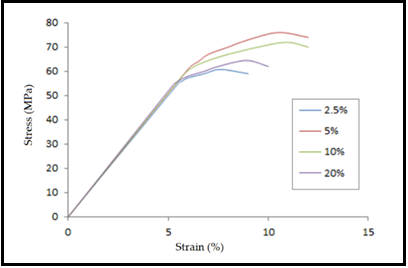Main Article Content
Abstract
Today, modification on motorcycle body cover has become a new automotive business. The main components for modifying the motor body cover are glass fibre, resin and catalyst. Catalysts are substances that can accelerate reactions, the more catalyst composition, the less time it takes to react. Therefore, this study aims to determine the effect of variations in catalysts on composite properties. The test is carried out by giving the catalyst in 4 variations (2.5%, 5%, 10%, and 20%) to 157 BQTN resin. The specimen was tested using ASTM D-256 for impact/hardness, ASTM D-790 for bending, and ASTM D-638 for tensile strength. During this study, we found that the 2.5% catalyst give good results for impact, bending, tensile strength, and also modulus young.
Keywords
Article Details
References
- T. P. Hovorun, K. V. Berladir, V. I. Pererva, S. G. Rudenko, and A. I. Martynov, “Modern materials for automotive industry,” Journal of Engineering Sciences, vol. 4, no. 2, pp. f8–f18, 2018.
- E. Ghassemieh, “Materials in Automotive Application, State of the Art and Prospects,” in New Trends and Developments in Automotive Industry, M. Chiaberge, Ed. London: IntechOpen, 2011, pp. 365–394.
- Lutiyatmi and T. Daryanto, “Pengaruh Proses Degassiing pada Peleburan Aluminium dengan Tungku Peleburannya,” Automotive Experiences, vol. 1, no. 2, pp. 53–57, 2018.
- H. C. Möhring, “Composites in Production Machines,” Procedia CIRP, vol. 66, pp. 2–9, 2017.
- F. C. Campbell, “Introduction to CompositeMaterials,” in Structure Composite Materials, vol. 1, ASTM International, 2010, pp. 1–29.
- A. K. Samlawi, Y. F. Arifin, and P. Y. Permana, “Pembuatan dan Karakterisasi Material Komposit Serat Ijuk (Arenga Pinata) sebagai bahan Baku Cover Body Sepeda Motor,” Info Teknik, vol. 3, no. April, pp. 289–300, 2018.
- F. D. Afandi and P. H. Tjahjanti, “Pembuatan Tameng Perisai Depan Motor Dari Bahan Komposit Dengan Penguat Serat Ijuk,” in Seminar Nasional dan Gelar Produk, 2017, pp. 225–234.
- F. Hussain, M. Hojjati, M. Okamoto, and R. E. Gorga, “Review article: Polymer-matrix nanocomposites, processing, manufacturing, and application: An overview,” Journal of Composite Materials, vol. 40, no. 17, pp. 1511–1575, 2006.
- R. R. Nagavally, “Composite Materials - History, Types, Fabrication Techniques, Advantages, and Applications,” International Journal of Mechanical And Production Engineering, vol. 5, no. 9, pp. 82–87, 2017.
- Y. Rafiq, A. A. Khan, and M. F. Hasan, “A Review on Natural Fibre Polymer Composites,” International Journal of Scientific Research Engineering & Technology, vol. 6, no. 2, pp. 81–86, 2017.
- M. A. Illah and H. Ardhyananta, “Pengaruh Jenis Katalis terhadap Kekuatan Tarik dan Stabilitas Termal Polidimetilsiloksan (PDMS) untuk Lapisan Pelindung Baja AISI 1050,” Jurnal Teknik Pomits, vol. 2, no. 1, p. F-41-F-44, 2013.
- D. Y. Lestari, “Pemilihan Katalis yang Ideal,” in Prosiding Seminar Nasional Penelitian, Pendidikan dan Penerapan MIPA, 2012, pp. 53–58.
- H. Chandle, Introduction to Hardness Testing. ASM International, 1999.

